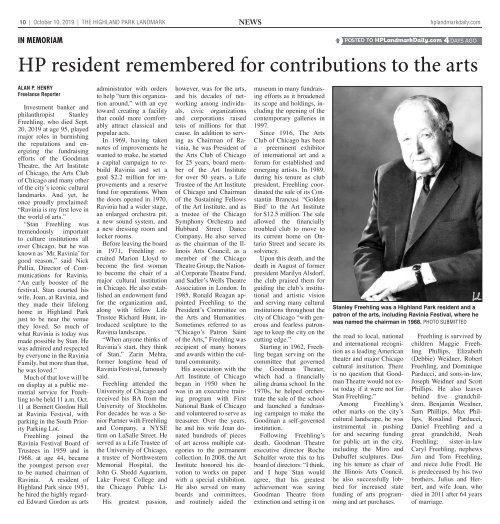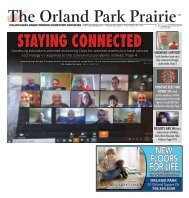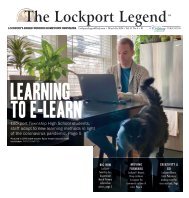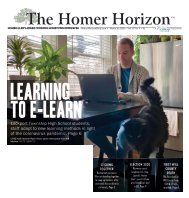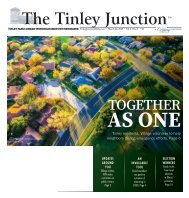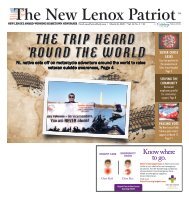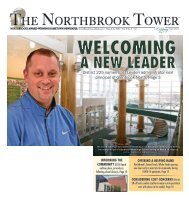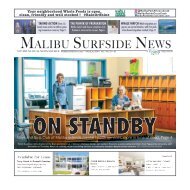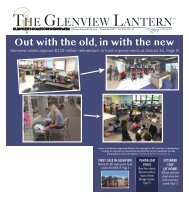HP101019
HP101019
HP101019
You also want an ePaper? Increase the reach of your titles
YUMPU automatically turns print PDFs into web optimized ePapers that Google loves.
10 | October 10, 2019 | The highland park landmark NEWS<br />
hplandmarkdaily.com<br />
In Memoriam<br />
HP resident remembered for contributions to the arts<br />
4<br />
Alan P. Henry<br />
Freelance Reporter<br />
Investment banker and<br />
philanthropist Stanley<br />
Freehling, who died Sept.<br />
20, 2019 at age 95, played<br />
major roles in burnishing<br />
the reputations and energizing<br />
the fundraising<br />
efforts of the Goodman<br />
Theatre, the Art Institute<br />
of Chicago, the Arts Club<br />
of Chicago and many other<br />
of the city’s iconic cultural<br />
landmarks. And yet, he<br />
once proudly proclaimed:<br />
“Ravinia is my first love in<br />
the world of arts.”<br />
“Stan Freehling was<br />
tremendously important<br />
to culture institutions all<br />
over Chicago, but he was<br />
known as `Mr. Ravinia’ for<br />
good reason,” said Nick<br />
Pullia, Director of Communications<br />
for Ravinia.<br />
“An early booster of the<br />
festival, Stan courted his<br />
wife, Joan, at Ravinia, and<br />
they made their lifelong<br />
home in Highland Park<br />
just to be near the venue<br />
they loved. So much of<br />
what Ravinia is today was<br />
made possible by Stan. He<br />
was admired and respected<br />
by everyone in the Ravinia<br />
Family, but more than that,<br />
he was loved.”<br />
Much of that love will be<br />
on display at a public memorial<br />
service for Freehling<br />
to be held 11 a.m. Oct.<br />
11 at Bennett Gordon Hall<br />
at Ravinia Festival, with<br />
parking in the South Priority<br />
Parking Lot.<br />
Freehling joined the<br />
Ravinia Festival Board of<br />
Trustees in 1959 and in<br />
1968, at age 44, became<br />
the youngest person ever<br />
to be named chairman of<br />
Ravinia. A resident of<br />
Highland Park since 1951,<br />
he hired the highly regarded<br />
Edward Gordon as arts<br />
administrator with orders<br />
to help “turn this organization<br />
around,” with an eye<br />
toward creating a facility<br />
that could more comfortably<br />
attract classical and<br />
popular acts.<br />
In 1969, having taken<br />
notes of improvements he<br />
wanted to make, he started<br />
a capital campaign to rebuild<br />
Ravinia and set a<br />
goal $2.2 million for improvements<br />
and a reserve<br />
fund for operations. When<br />
the doors opened in 1970,<br />
Ravinia had a wider stage,<br />
an enlarged orchestra pit,<br />
a new sound system, and<br />
a new dressing room and<br />
locker rooms.<br />
Before leaving the board<br />
in 1971, Freehling recruited<br />
Marion Lloyd to<br />
become the first woman<br />
to become the chair of a<br />
major cultural institution<br />
in Chicago. He also established<br />
an endowment fund<br />
for the organization and,<br />
along with fellow Life<br />
Trustee Richard Hunt, introduced<br />
sculpture to the<br />
Ravinia landscape.<br />
“When anyone thinks of<br />
Ravinia’s start, they think<br />
of Stan,” Zarin Mehta,<br />
former longtime head of<br />
Ravinia Festival, famously<br />
said.<br />
Freehling attended the<br />
University of Chicago and<br />
received his BA from the<br />
University of Stockholm.<br />
For decades he was a Senior<br />
Partner with Freehling<br />
and Company, a NYSE<br />
firm on LaSalle Street. He<br />
served as a Life Trustee of<br />
the University of Chicago,<br />
a trustee of Northwestern<br />
Memorial Hospital, the<br />
John G. Shedd Aquarium,<br />
Lake Forest College and<br />
the Chicago Public Library.<br />
His greatest passion,<br />
however, was for the arts,<br />
and his decades of networking<br />
among individuals,<br />
civic organizations<br />
and corporations raised<br />
tens of millions for that<br />
cause. In addition to serving<br />
as Chairman of Ravinia,<br />
he was President of<br />
the Arts Club of Chicago<br />
for 25 years, board member<br />
of the Art Institute<br />
for over 50 years, a Life<br />
Trustee of the Art Institute<br />
of Chicago and Chairman<br />
of the Sustaining Fellows<br />
of the Art Institute, and as<br />
a trustee of the Chicago<br />
Symphony Orchestra and<br />
Hubbard Street Dance<br />
Company. He also served<br />
as the chairman of the Illinois<br />
Arts Council, as a<br />
member of the Chicago<br />
Theatre Group, the National<br />
Corporate Theatre Fund,<br />
and Sadler’s Wells Theatre<br />
Association in London. In<br />
1985, Ronald Reagan appointed<br />
Freehling to the<br />
President’s Committee on<br />
the Arts and Humanities.<br />
Sometimes referred to as<br />
“Chicago’s Patron Saint<br />
of the Arts,” Freehling was<br />
recipient of many honors<br />
and awards within the cultural<br />
community.<br />
His association with the<br />
Art Institute of Chicago<br />
began in 1950 when he<br />
was in an executive training<br />
program with First<br />
National Bank of Chicago<br />
and volunteered to serve as<br />
treasurer. Over the years,<br />
he and his wife Joan donated<br />
hundreds of pieces<br />
of art across multiple categories<br />
to the permanent<br />
collection. In 2008, the Art<br />
Institute honored his devotion<br />
to works on paper<br />
with a special exhibition.<br />
He also served on many<br />
boards and committees,<br />
and routinely aided the<br />
museum in many fundraising<br />
efforts as it broadened<br />
its scope and holdings, including<br />
the opening of the<br />
contemporary galleries in<br />
1997.<br />
Since 1916, The Arts<br />
Club of Chicago has been<br />
a preeminent exhibitor<br />
of international art and a<br />
forum for established and<br />
emerging artists. In 1989,<br />
during his tenure as club<br />
president, Freehling coordinated<br />
the sale of its Constantin<br />
Brancusi “Golden<br />
Bird’ to the Art Institute<br />
for $12.5 million. The sale<br />
allowed the financially<br />
troubled club to move to<br />
its current home on Ontario<br />
Street and secure its<br />
solvency.<br />
Upon this death, and the<br />
death in August of former<br />
president Marilyn Alsdorf,<br />
the club praised them for<br />
guiding the club’s institutional<br />
and artistic vision<br />
and serving many cultural<br />
institutions throughout the<br />
city of Chicago “with generous<br />
and fearless patronage<br />
to keep the city on the<br />
cutting edge.”<br />
Starting in 1962, Freehling<br />
began serving on the<br />
committee that governed<br />
the Goodman Theater,<br />
which had a financially<br />
ailing drama school. In the<br />
1970s, he helped orchestrate<br />
the sale of the school<br />
and launched a fundraising<br />
campaign to make the<br />
Goodman a self-governed<br />
institution.<br />
Following Freehling’s<br />
death, Goodman Theatre<br />
executive director Roche<br />
Schulfer wrote this to his<br />
board of directors: “I think,<br />
and I hope Stan would<br />
agree, that his greatest<br />
achievement was saving<br />
Goodman Theatre from<br />
extinction and setting it on<br />
Stanley Freehling was a Highland Park resident and a<br />
patron of the arts, including Ravinia Festival, where he<br />
was named the chairman in 1968. Photo submitted<br />
the road to local, national<br />
and international recognition<br />
as a leading American<br />
theater and major Chicago<br />
cultural institution. There<br />
is no question that Goodman<br />
Theatre would not exist<br />
today if it were not for<br />
Stan Freehling.”<br />
Among Freehling’s<br />
other marks on the city’s<br />
cultural landscape, he was<br />
instrumental in pushing<br />
for and securing funding<br />
for public art in the city,<br />
including the Miro and<br />
Dubuffet sculptures. During<br />
his tenure as chair of<br />
the lllinois Arts Council,<br />
he also successfully lobbied<br />
for increased state<br />
funding of arts programming<br />
and art purchases.<br />
Freehling is survived by<br />
children Maggie Freehling<br />
Phillips, Elizabeth<br />
(Debbie) Weidner, Robert<br />
Freehling, and Dominique<br />
Parducci, and sons-in-law,<br />
Joseph Weidner and Scott<br />
Phillips. He also leaves<br />
behind five grandchildren,<br />
Benjamin Weidner,<br />
Sam Phillips, Max Phillips,<br />
Rosalind Parducci,<br />
Daniel Freehling and a<br />
great grandchild, Noah<br />
Freehling; sister-in-law<br />
Caryl Freehling, nephews<br />
Jim and Tom Freehling,<br />
and niece Julie Frodl. He<br />
is predeceased by his two<br />
brothers, Julius and Herbert,<br />
and wife Joan, who<br />
died in 2011 after 64 years<br />
of marriage.


